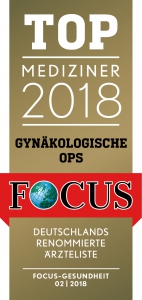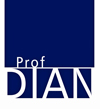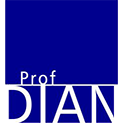
Oncological Surgery
Prof Dian acquired the necessary clinical knowledge as well as extensive operative skills in the field of oncology through intensive further training at the University Women’s Clinic Hamburg Eppendorf (UKE) and at the Women’s Clinic of the LMU in Munich. Until 2016, Prof Dian was as coordinator of the Breast and Genital Centre of the LMU to a considerable extent mainly in charge of the cooperation among the gynaecological centres and the other organ centres under the roof of the “Comprehensive Cancer Center” at the LMU, of which he is still a cooperation partner. He was able to improve the operative techniques even further by research trips abroad, where he met renowned oncological surgeons such as Prof Silverstein in L.A. and Prof Pitanguy in Rio de Janeiro. Due to Prof Dian, endoscopic oncological surgery has been successfully established at the Women’s Clinic of the LMU, so that almost all of these surgeries are conducted “minimally invasive”. During the last years, he has been developing these operative techniques even further and has inaugurated innovative operative concepts that have received international attention.
Prof Dian has conducted a large number of oncological breast- and minimally invasive surgeries. The high quality of his work has earned him the status of being one of the 74 certified German breast surgeons as well as one of the 46 certified German minimally invasive surgeons with the highest level III. Furthermore, he is as member of the board of the Working Committee for Reconstructive Operations in Gynaecology (AWOgyn) in charge of monitoring oncological breast surgeries. He is also active member of the Working Group for Oncology and of the Munich Tumour Centre. Finally yet importantly, he is one of the main authors of the chapter “Operative Therapy” published in the “Tumour Manual Munich”, one of the German standard works on breast cancer therapy.
Prof Dian is training supervisor for oncological surgery, is deployed as “flying doctor” for minimally invasive oncological surgery all over Germany and certifies oncological breast surgeons. He operates regularly at the German Forum for Operative Gynaecology and is nationally one of the leading surgeons in the field.
In 2007, he completed extra training for “gynaecological oncology” and “special obstetrics and perinatal medicine”, which have been his sub-specializations since then. In this clinic, Prof Dian is primarily responsible for operative as well as conservative oncology.
Since 2014, Prof Dian has been included in the annually updated list of “Top Physicians” of the weekly magazine FOCUS in the categories “Breast Cancer and Gynaecological Tumours” and “Breast Surgery”.
A very competent and kind surgeon. My surgery went very well. Prof Dr Dr Dian explained everything in great detail and intensively took care of me after the surgery. I had a breast-conserving surgery and the scars are almost invisible. I am very happy and satisfied and can highly recommend Prof Dr Dr Dian. Thank you so much!
Endoscopy
During the last years, minimally invasive surgery with its millimetre-sized incisions has increasingly replaced open surgery with its classic abdominal incision for almost all indications. Typical characteristics of this new technology are the reduction of pain, shorter post-operative recovery, earlier re-entry into professional life and an improved cosmetic result. These new procedures still the patient’s fears and are physically far less distressing than former techniques.


Endoscopy
During the last years, minimally invasive surgery with its millimetre-sized incisions has increasingly replaced open surgery with its classic abdominal incision for almost all indications. Typical characteristics of this new technology are the reduction of pain, shorter post-operative recovery, earlier re-entry into professional life and an improved cosmetic result. These new procedures still the patient’s fears and are physically far less distressing than former techniques.

Breast Surgery
Diagnosis Breast Cancer – What You Should Know
When breast cancer is diagnosed, it means your life will change abruptly. You will have to make numerous decisions within a small period. Most of them are related to the therapy and directly linked to restoring your health. The physical restoration is one important psychological aspect for many women.
Breast Reconstruction after Breast Cancer Diagnosis
There is quite a range of operative solutions available for breast reconstruction from which female patients with diagnosed breast cancer can choose. Take your time in deciding whether you want a reconstruction and if so, which type you prefer. Breast conserving surgery (BCS) is the method applied in 70 to 80 percent of the cases. During this procedure, the tumour is removed together with a sufficient margin of healthy tissue. An aesthetically appealing form can be achieved by shifting the tissue accordingly. In more than 90 percent of the cases, there will be no noticeable asymmetry after treatment. The surgery is usually followed by radiotherapy for the diagnosed breast. In very few cases, the size of the other breast needs to be adjusted through reduction.
Reconstruction with Implants
Heterologous or implant reconstruction means that the removal of the tumour and the glandular tissue is followed by restoring the original shape with the help of implants. Very often this takes place during the same operative session. The removed tissue is then immediately replaced with the implant. Therefore, this procedure is called direct-to-implant or primary reconstruction. Sometimes a tissue expander is placed beforehand in order to prepare the necessary location of the implant. The expander is gradually filled with saline solution and widens the skin, thus ensuring that there is enough space for the implant. This technique is mainly used when the tumour was removed a long time ago and there is not enough space available underneath the skin. This so-called secondary reconstruction is usually undertaken in two separate surgeries.
Reconstruction with Tissue from Other Parts of the Patient’s Body
The autologous breast reconstruction or flap plasty technique transplants the patient’s own tissue from other parts of the body into the breast. By using a pedicled flap the transplant is left partly attached to the donor site to supply the tissue with blood. The free flap is completely detached from the donor site and gets microsurgically connected to the blood-vessel system at the recipient site. The advantage of taking tissue from your lower abdomen is that parallel to the breast’s reconstruction the lower abdomen undergoes a lifting. The following compression for four up to six weeks results in a permanently good result for the abdomen.
Your body is a miracle – it deserves to be treated well


